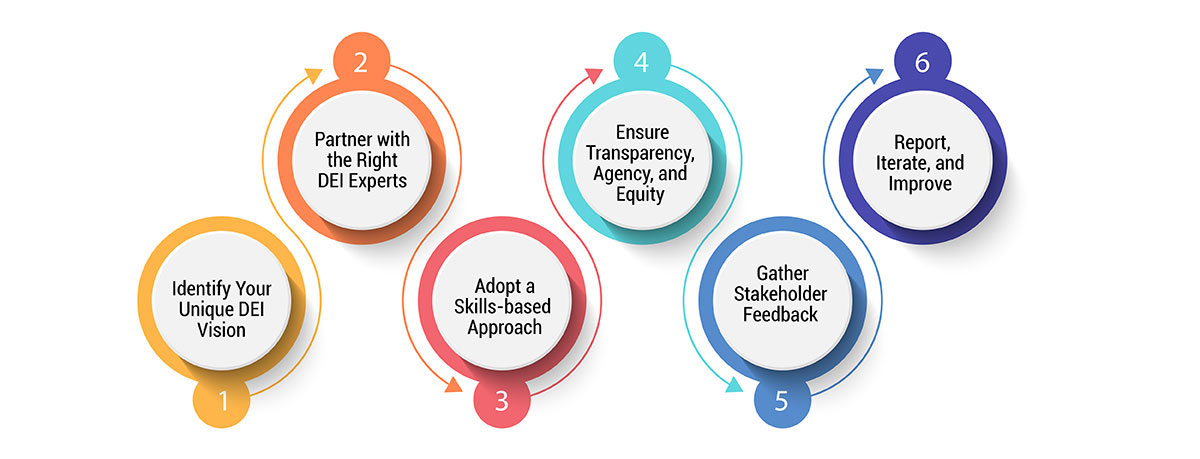In today's inclusive workplace, a strong diversity, equity, and inclusion (DEI) strategy is essential for businesses that want to stay competitive. Companies that prioritize DEI are better positioned to attract top talent, drive innovation, improve decision-making, and ultimately boost their bottom line.
However, many organizations struggle to develop and execute an effective DEI strategy. A 2021 study by HR Dive found that about 76% of companies have no diversity and inclusion goals.
This comprehensive article will walk you through the process of creating a robust DEI strategy in six stages while sharing seven tips to avoid common pitfalls. By the end, you'll have a clear roadmap to build a diverse, equitable, and inclusive workplace culture that aligns with your business strategy.
The following six steps will help create a powerful DEI strategy:

Before you can make meaningful progress, it's crucial to take stock of your current processes and understand where you stand. Ask yourself: "Where do I stand now on DEI initiatives?" and "What would my ideal hiring and workplace culture look like if there were no limitations?"
Next, consider your company's specific objectives and challenges regarding DEI and talent management. This self-reflection will help you establish an accurate benchmark and set the foundation for your DEI vision.
Turning your DEI vision into reality requires a flexible system and an experienced partner to guide you through the process. Look for a vendor that not only provides robust technology but also offers expertise, best practices, and a deep understanding of your business challenges and cultural context.
A true partnership with your technology vendor allows you to leverage their knowledge and experience while ensuring your DEI strategy aligns with regional regulations and your organizational needs.
One of the latest recruiting and talent management trends is focusing on skills rather than traditional indicators like work experience and academic achievements. This skills-based approach naturally diversifies your talent pool by reducing unconscious biases and leveling the playing field for candidates from broader backgrounds.
Implementing a skills-based approach at scale requires the right technology. For example, AI-powered tools can help sourcers discover hidden gems within your database or on the open web-based on specific skill sets. Recruiters can also promote diverse hiring by leveraging skill-powered candidate recommendations, broadening the range of talent for each requisition.
While skills and AI are powerful tools, an inclusive hiring process should also prioritize transparency, agency, and equity. Provide external applicants with a one-stop-shop career marketplace that highlights your DEI initiatives and offers personalized job recommendations based on their skills and experience.
For existing employees, create a bustling talent marketplace with tailored learning recommendations, upskilling opportunities, and internal job opportunities. Encourage collaboration and mentorship programs to support career growth and skill development.
Collecting honest, unfiltered feedback from candidates, employees, recruiters, and hiring managers is crucial to optimizing your DEI efforts. Use automated, branded surveys to gain insights into how your initiatives are performing in practice and identify areas for improvement.
Engaging with talent in this way, regardless of their application outcome, shows your commitment to continuous improvement and keeps your organization top-of-mind for future career opportunities.
Analyze the data collected throughout the process and assess the impact of your DEI initiatives against the established KPIs and goals. A powerful, flexible platform should allow stakeholders to create custom reports and dashboards, providing real-time insights to drive evidence-based actions.
Treat DEI as an ongoing journey, continually iterating and improving your strategy based on data-driven insights and stakeholder feedback.
Here are 7 tips:
Creating an impactful DEI strategy is not a one-time event but an ongoing journey that requires commitment, effort, and continuous improvement. By following these seven essential tips, you'll be well on your way to building a more diverse, equitable, and inclusive workplace that drives business success and creates a better future for all.
Building a diverse, equitable, and inclusive workplace is an ongoing journey that requires a strategic and comprehensive approach. By following the six steps and seven tips outlined in this guide, you'll be well on your way to creating a winning DEI strategy that aligns with your business objectives and drives real impact.
Remember, an effective DEI strategy starts with a clear vision, leverages the expertise of the right partners, and adopts a skills-based approach to reduce unconscious biases. It also prioritizes transparency, agency, and equity throughout the entire employee lifecycle, from attracting diverse talent to supporting their growth and development within the organization.
Continuously gathering feedback from stakeholders and using data-driven insights to iterate and improve your strategy is crucial for long-term success. And by connecting your DEI initiatives to your company's core values and mission, you'll foster a culture of inclusion that permeates every aspect of your business.
While the journey may seem daunting, the rewards of a diverse, equitable, and inclusive workplace are immense. From attracting top talent and driving innovation to improving decision-making and boosting your bottom line, a well-executed DEI strategy can give your organization a competitive edge.
So, take the first step today and start building a DEI strategy that not only aligns with your business goals but also reflects your commitment to creating a better, more inclusive world for all.

CredBadge™ is a proprietary, secure, digital badging platform that provides for seamless authentication and verification of credentials across digital media worldwide.
CredBadge™ powered credentials ensure that professionals can showcase and verify their qualifications and credentials across all digital platforms, and at any time, across the planet.

Keep yourself informed on the latest updates and information about business strategy by subscribing to our newsletter.